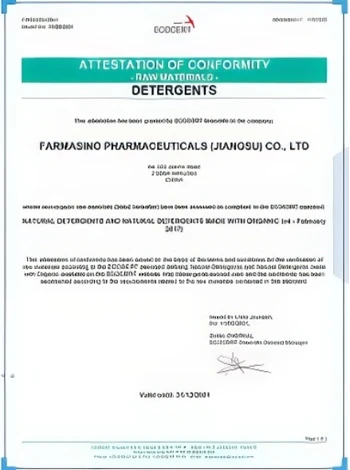



sodium bisulphate msds
Sodium Bisulfate A Comprehensive Overview
Sodium bisulfate, also known as sodium hydrogen sulfate, is a chemical compound with the formula NaHSO4. It is a white crystalline powder that is hygroscopic, meaning it can absorb moisture from the air. This compound is commonly used in various industries, including food processing, chemical manufacturing, and water treatment, due to its acidic properties and ability to lower pH levels. Understanding its properties, uses, and safety measures is essential for anyone working with or handling this substance.
Properties
Sodium bisulfate is a strong acid salt formed from the neutralization of sulfuric acid with sodium hydroxide. It appears as white granular or powdered solid that is highly soluble in water. In aqueous solutions, it dissociates to release hydrogen ions, which contribute to its acidic nature. The pH of a typical sodium bisulfate solution can range from 1 to 2, making it an effective acidifying agent.
In addition to its solubility, sodium bisulfate is stable under normal conditions, but it can decompose when exposed to high temperatures, releasing sulfur trioxide and other gases. This stability makes it a popular choice for use in various applications.
Applications
1. pH Control One of the primary uses of sodium bisulfate is in the regulation of pH levels. It is commonly used in swimming pools to lower the pH of the water, enhancing the effectiveness of chlorine disinfectants.
2. Food Industry In the food industry, sodium bisulfate serves as an acidulant. It can be used in processes like food preservation and can also modify the texture and flavor of certain food products.
sodium bisulphate msds

3. Laboratory Use In laboratories, sodium bisulfate is used for pH adjustment in various chemical processes. Its ability to act as a dehydrating agent is also leveraged in certain analytical procedures.
4. Industrial Cleaning The compound is employed in cleaning formulations as a descaler and to remove oxides from metal surfaces. Its acidic properties help dissolve scale and rust effectively.
Safety Considerations
While sodium bisulfate has many beneficial applications, it is important to handle it with care. According to the Material Safety Data Sheet (MSDS), sodium bisulfate can cause irritation to the skin, eyes, and respiratory tract. Adequate personal protective equipment (PPE) such as gloves, goggles, and masks should be worn when handling the chemical to minimize exposure.
In case of contact with skin or eyes, it is crucial to rinse the affected area thoroughly with water and seek medical attention if irritation persists. Additionally, sodium bisulfate should be stored in a cool, dry place, away from incompatible substances such as strong bases and reactive metals.
Conclusion
Sodium bisulfate is a versatile compound with various applications across different industries, primarily due to its ability to lower pH and act as a mild acid. Understanding its properties and safety precautions ensures that it can be used effectively while minimizing risks to health and safety. As with any chemical, proper handling and knowledge are essential for safe use in both industrial and domestic environments.
-
Why Sodium Persulfate Is Everywhere NowNewsJul.07,2025
-
Why Polyacrylamide Is in High DemandNewsJul.07,2025
-
Understanding Paint Chemicals and Their ApplicationsNewsJul.07,2025
-
Smart Use Of Mining ChemicalsNewsJul.07,2025
-
Practical Uses of Potassium MonopersulfateNewsJul.07,2025
-
Agrochemicals In Real FarmingNewsJul.07,2025
-
Sodium Chlorite Hot UsesNewsJul.01,2025










